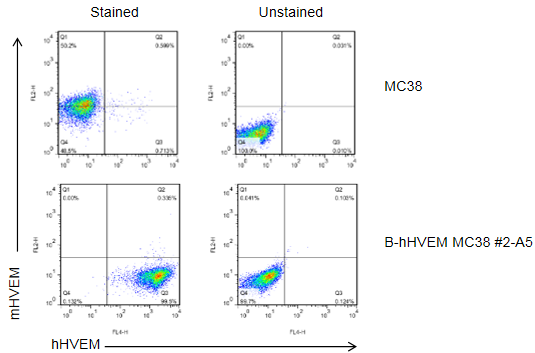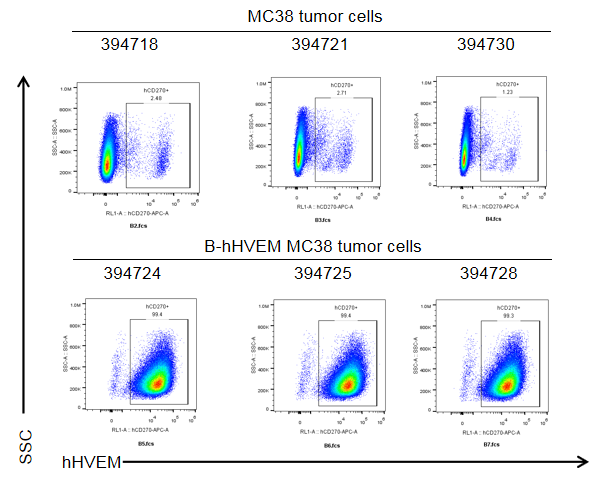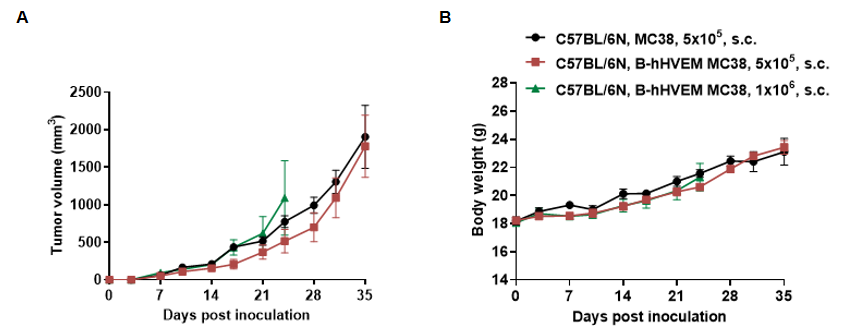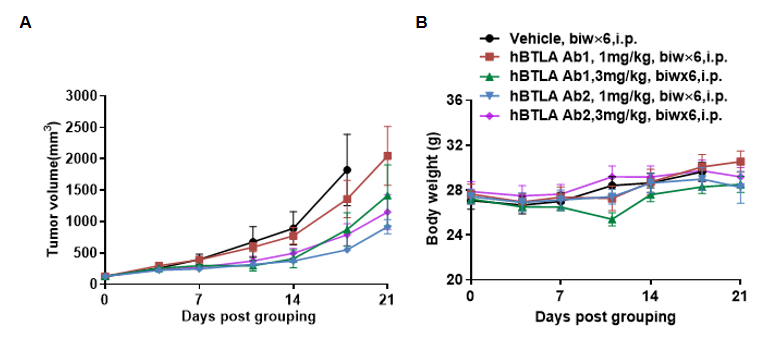


• 310693
| Product name | B-hHVEM MC38 |
|---|---|
| Catalog number | 310693 |
| Strain background | C57BL/6 |
| Aliases | TNFRSF14, CD270 |
| Tissue | Colon |
| Disease | Colon carcinoma |
| Species | Mouse |
| Application | B-hHVEM MC38 cells have the capability to establish tumors in vivo and can be used for efficacy studies. |
on this page
The mouse Hvem gene was replaced by human HVEM coding sequence in B-hHVEM MC38 cells. Human HVEM is highly expressed on the surface of B-hHVEM MC38 cells.
Gene targeting strategy for B-hHVEM MC38 cells. The exogenous promoter and human HVEM coding sequence were inserted to replace part of murine exon 3 and all of exon 4. The insertion disrupts the endogenous murine Hvem gene, resulting in a non-functional transcript.



Subcutaneous homograft tumor growth of B-hHVEM MC38 cells. B-hHVEM MC38 cells (5x105 and 1x106) and wild-type MC38 cells (5x105) were subcutaneously implanted into C57BL/6N mice (female, 5-8-week-old, n=5). Tumor volume and body weight were measured twice a week. (A) Average tumor volume ± SEM. (B) Body weight (Mean± SEM). Volume was expressed in mm3 using the formula: V=0.5 X long diameter X short diameter2. As shown in panel A, B-hHVEM MC38 cells were able to establish tumors in vivo and can be used for efficacy studies.

Subcutaneous homograft tumor growth of B-hHVEM MC38 cells. B-hHVEM MC38 cells (1x106) and wild-type MC38 cells (5x105) were subcutaneously implanted into homozygous B-hBTLA/hHVEM mice (female, 6-week-old, n=7). Tumor volume and body weight were measured twice a week. (A) Average tumor volume ± SEM. (B) Body weight (Mean ± SEM). Volume was expressed in mm3 using the formula: V=0.5 X long diameter X short diameter2. As shown in panel A, B-hHVEM MC38 cells were able to form tumors in vivo and can be used for efficacy studies.

B-hHVEM MC38 tumor growth of individual mice. B-hHVEM MC38 cells (5x105 and 1x106) and wild-type MC38 cells (5x105) were subcutaneously implanted into C57BL/6N mice (female, 5-8-week-old, n=5). As shown in panel, B-hHVEM MC38 cells were able to establish tumors in vivo and can be used for efficacy studies.

B-hHVEM MC38 tumor cells growth of individual mice. B-hHVEM MC38 cells (1x106) and wild-type MC38 cells (5x105) were subcutaneously implanted into homozygous B-hBTLA/hHVEM mice (female, 6-week-old, n=7). As shown in panel, B-hHVEM MC38 cells were able to establish tumors in vivo and can be used for efficacy studies.
